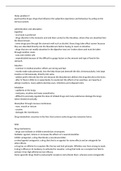Samenvatting
Summary 1.4 the human body problem 4; drugs
- Instelling
- Erasmus Universiteit Rotterdam (EUR)
in this summary you will find everything you need to know about drugs, the effects they have, how they work on a neurological level and what kind of drugs there are and the differences between them .
[Meer zien]




